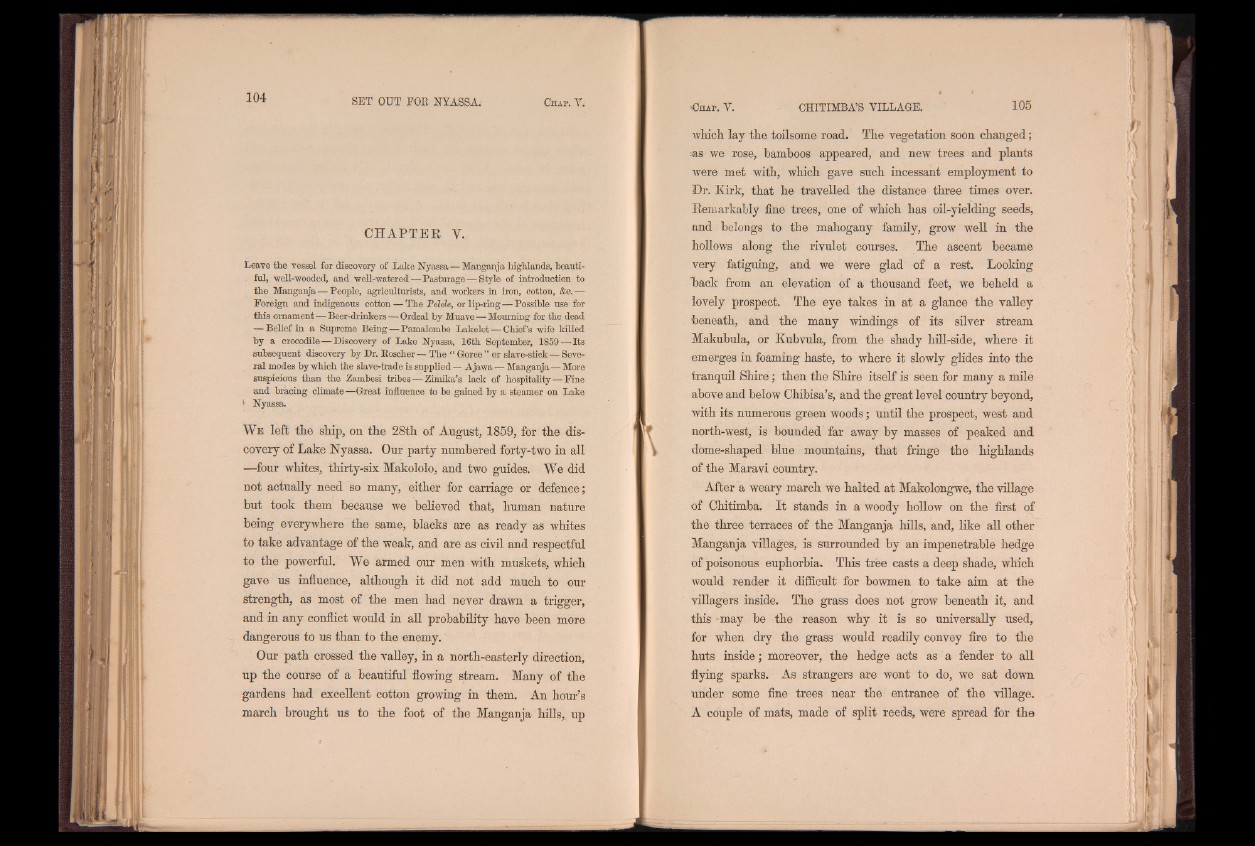
C H A P T E R Y.
Leave tie vessel for discovery of Late Nyassa — Manganja highlands, beautiful,
well-wooded, and well-watered—Pasturage—Style of introduction to
the Manganja — People, agriculturists, and workers in iron, cotton, &c.—
Foreign and indigenous cotton — The Pelele, or lip-ring — Possible use for
this ornament—Beer-drinters—Ordeal by Muave—Mourning for the dead
— Belief in a Supreme Being — Pamalombe Lakelet — Chiefs wife killed
by a crocodile — Discovery of Lake Nyassa, 16th September, 1859 f l i t s
subsequent discovery by Dr. Roscher — The “ Goree ” or slave-stiok—Several
modes by which the slave-trade is supplied — Ajawa — Manganja — More
suspicious than the Zambesi tribes — Zimika’s lack of hospitality—Fine
and bracing climate —Great influence to be gained by a steamer on Lake
| Nyassa.
We left the ship, on the 28th of August, 1859, for the discovery
of Lake Nyassa. Our party numbered forty-two in all
—four whites, thirty-six Makololo, and two guides. We did
not actually need so many, either for carriage or defence;
but took them because we believed that, human nature
being everywhere the same, blacks are as ready as whites
to take advantage of the weak, and are as civil and respectful
to the powerful. We armed our men with muskets, which
gave us influence, although it did not add much to our
strength, as most of the men had never drawn a trigger,
and in any conflict would in all probability have been more
dangerous to us than to the enemy.
Our path crossed the valley, in a north-easterly direction,
up the course of a beautiful flowing stream. Many of the
gardens had excellent cotton growing in them. An hour’s
march brought us to the foot of the Manganja hills,, up
which lay the toilsome road. The vegetation soon changed;
•as we rose, bamboos appeared, and new trees and plants
were met with, which gave such incessant employment to
Dr. Kirk, that he travelled the distance three times over.
Remarkably fine trees, one of which has oil-yielding seeds,
and belongs to the mahogany family, grow well in the
hollows along the rivulet courses. The ascent became
very fatiguing, and we were glad of a rest. Looking
back from an elevation of a thousand feet, we beheld a
lovely prospect. The eye takes in at a glance the valley
beneath, and the many windings of its silver stream
Makubula, or Kubvula, from the shady hill-side, where it
emerges in foaming haste, to where it slowly glides into the
tranquil Shire; then the Shire itself is seen for many a mile
above and below Chibisa’s, and the great level country beyond,
with its numerous green woods; until the prospect, west and
north-west, is bounded far away by masses of peaked and
dome-shaped blue mountains, that fringe the highlands
of the Maravi country.
After a weary march we halted at Makolongwe, the village
of Chitimba. I t stands in a woody hollow on the first of
the three terraces of the Manganja hills, and, like all other
Manganja villages, is surrounded by an impenetrable hedge
of poisonous euphorbia. This tree casts a deep shade, which
would render it difficult for bowmen to take aim at the
villagers inside. The grass does not grow beneath it, and
this -may be the reason why it is so universally used,
for when dry the grass would readily convey fire to the
huts inside; moreover, the hedge acts as a fender to all
flying sparks. As strangers are wont to do, we sat down
under some fine trees near the entrance of the village.
A couple of mats, made of split reeds, were spread for the